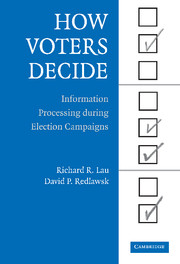Book contents
- Frontmatter
- Contents
- List of Tables and Figures
- Acknowledgments
- HOW VOTERS DECIDE
- I Theory and Methods
- II Information Processing
- III Politics
- IV Conclusion
- Appendix A Detailed Examples of Decision Strategies in Action
- Appendix B How the Dynamic Information Board Works
- Appendix C Overview of Experimental Procedures
- Appendix D Detailed Decision Scripts
- Appendix E Calculating the On-line Evaluation Counter
- References
- Index
- Titles in the series
Appendix B - How the Dynamic Information Board Works
Published online by Cambridge University Press: 05 September 2012
- Frontmatter
- Contents
- List of Tables and Figures
- Acknowledgments
- HOW VOTERS DECIDE
- I Theory and Methods
- II Information Processing
- III Politics
- IV Conclusion
- Appendix A Detailed Examples of Decision Strategies in Action
- Appendix B How the Dynamic Information Board Works
- Appendix C Overview of Experimental Procedures
- Appendix D Detailed Decision Scripts
- Appendix E Calculating the On-line Evaluation Counter
- References
- Index
- Titles in the series
Summary
The dynamic information board is the most reasonable way to track information processing during a political campaign. The dynamic board allows the experimenter to establish any number of experimental conditions and randomly assign subjects to those conditions. The system used in these experiments can be employed to study both a primary and a general election campaign cycle. Further, the number of candidates can be varied, as can the amount of time available, along with other attributes of the campaign.
Information was presented to the subject on a computer screen, and the subject used a mouse to make selections from whatever is currently available on the screen. The order in which information was presented varied randomly according to the relative likelihood of any particular piece of information becoming available at different points in the campaign. These probabilities were based on the data from the 1988 presidential election campaign summarized in Figure 3.1.
There are four distinct areas on the main screen. The central area (see Figure 3.2 for an example) contains the six information boxes, which continuously move down the screen, with the box at the bottom disappearing, and a new information box appearing at the top of the stack. This is the area that subjects click on in order to learn more details about issues, candidate personalities, polls, endorsements, candidate backgrounds, and any other information the experimenter makes available.
- Type
- Chapter
- Information
- How Voters DecideInformation Processing in Election Campaigns, pp. 279 - 286Publisher: Cambridge University PressPrint publication year: 2006

